青い鳥をつかまえようと追いかける、という物語があります。でも逆に、小鳥に追いかけられる、という物語は、私は寡聞にして知りません。もし小鳥に追いかけられるとしたら、虫にとっては命の危険を感じるでしょうが、
人間にとっては、なんだか楽しい体験でしょう。
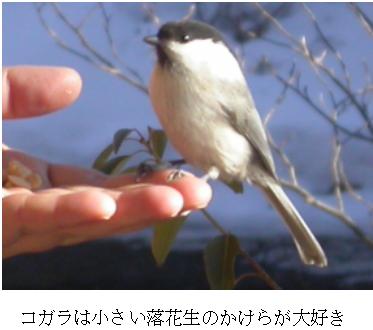
ソフィアート・ガーデンを歩いていると、どこからともなく楽しげに小鳥たちが飛んできて、「ッッッ」とか「ススス」という小さな鈴を鳴らすような声でこちらに合図します。見上げて声の主を探すと、傍の木の枝に、私どもを見ている小鳥がいます。だいたいはヤマガラかコガラ、時にはヒガラ、まれにシジュウカラだったりします。
そんな時、私どもは庭仕事の作業中でスコップや熊手や箒を持っていようとも、また大事な作業の最中であろうとも、野暮用の道具を捨て置いて、少しあせりながらも、ポケットから彼らへのプレゼントを差し出します。プレゼントの中身はヒマワリの種や落花生のかけら、あるいは胡桃のかけら、エゴの実などです。
すると彼らは本当に嬉しそうに、差し出した手にふわりと乗り、こちらの目をじっと覗き込んでから、好みのプレゼントをもらって、さっと枝に戻り、プレゼントを両足をそろえてきちんと掴んで、少しずつ食べます。食べながら、嬉しいときに出す「ススス」という小さな声も聞こえてきます。たまには、プレゼントをちゃっかり地面に隠して、再度もらいに来ることもあります。
私どもは、冬の間はいつでもポケットに、こうしたプレゼントを携えて庭に出ます。うっかり手ぶらで歩いていると、ガーデンで私どもの姿を見つけて、せっかく遠くから小鳥たちが遊びに飛んで来たときに、プレゼントをあげられなくてがっかりさせてしまうからです。
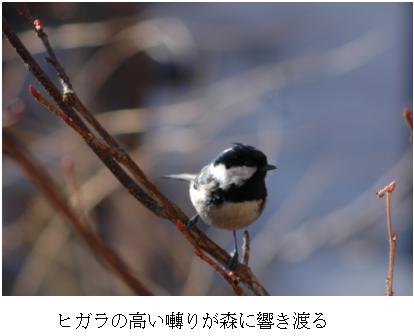
もちろん、ガーデンの小鳥たちは、大自然の中で生きる野生の生きものであり、ペットではありません。そもそも野鳥は鳥獣保護法によって保護されていますので、あくまで人間は野鳥との距離を保ちつつ、付き合わなければいけません。
そこでソフィアート・ガーデンにおいては、私どもは、あたり一面雪景色になり大地が凍る厳冬期から春先までの期間限定で、彼らにささやかなプレゼントとして、日中の間、ヒマワリの種を籠に入れて木に掛けておくことにしています。
英語圏ではこうしたバードフィーダーと呼ばれるものが実に数多くあり、感心するようなアイデア商品や、おしゃれなガーデングッズとしてさまざまな種類が販売されています。日本でも、バードハウスと呼ばれる巣箱やフィーダーのおしゃれな専門店もあるようです。
私どものフィーダーは素朴な蔓で編んだ籠ですが、小鳥たちには大人気の籠です。この籠を持ってガーデンの木の枝に掛けにいくときは、もう掛ける前から、小鳥たちがワクワクと待ち遠しい表情で思い思いの枝に止まってこちらに注目しています。
中には人懐っこい小鳥たちも何羽かいて、枝に掛ける前の、まだこちらが手に持っている籠の上に乗ってきたり、ほんの数センチの近さの枝にとまってこちらの顔を覗き込んでみたり、ちょっといたずらしたりして、こちらの動きや反応を観察する個体が現れます。
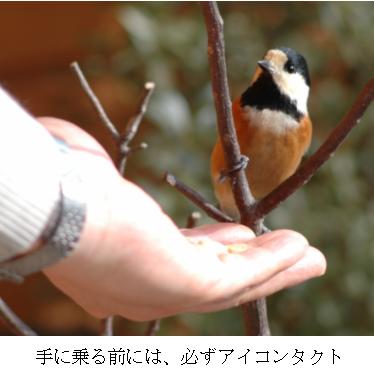
そうしたときには、自分自身が木になったつもりで心を鎮めます。彼らを驚かさないように極力ゆっくり動くように配慮します。決して邪魔をせず、しかし心を込めて小声で話しかけ、木の枝のように手を差し伸べます。心の水面を鏡のように落ち着かせ、何も考えず、ただひたすら無心に、手に乗ってくれた小鳥の姿をイメージしてじーっと待ちます。
そうすると、ある瞬間、あまりにも軽い小鳥が一瞬ふわりと手に乗り、こちらの目を覗き込んで、ヒマワリなどを何も取らずにさっと飛び去ります。こちらに邪心の無いことを確信すると、やがて私どもが差し出した手に安心して乗るようになり、ヒマワリの種や落花生などを受け取ってくれるようになります。
そんなときに彼らは必ずアイコンタクトを交わしてこちらの意図を確認します。一秒に満たないほんの瞬間ですが、こちらの目から考えていることを全て読み取っているようです。こちらが目をそらしたり、目を閉じているときは、プレゼントとして理解しないのか、手に乗っても何も受け取らずに飛び去ることもあります。
そうした関係が二、三年と続くうちに、もうすっかりお互い顔なじみになり、また小鳥たちが営巣し雛を育てていく場面で安心感が代々引き継がれていきます。もちろん個体の顔(ヒトと同じで鳥も顔で見分けがつくようになります)も私どもは覚えています。
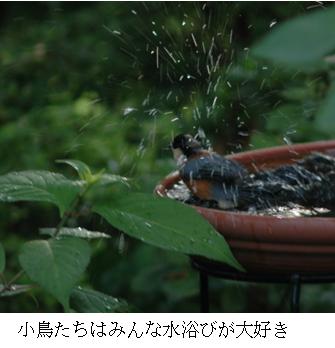
私どもが水場を新鮮な水で満たしたり、小鳥の安心する木を植えたり、巣箱を手入れして掛けたりする姿を、すべて小鳥たちは見ています。
私どもが巣箱を掛ける作業をしている最中、ある仲良しのヤマガラは嬉しさのあまり(?)、手と巣箱の間のわずかな隙間をすりぬけて旋回して遊んだりもしました。
そうした日常の何気ない行為の中で、基本的な信頼関係が築かれると、小鳥たちは実に細やかで豊かな感情表現を私どもに対して見せてくれるようになります。
近くには自由にとれる籠の中に、ヒマワリや落花生など彼らの好物があるというのに、わざわざ離れたところで庭仕事をしている私どもの後を追って飛んできて、遊びたそうな表情で「ススス」と合図し、差し出した手に乗ってくれる小鳥たちもいます。こちらが「おーい」と手を振ると、数メートル先からこちらを見つけて飛んできて、手に乗ってくれる律儀な小鳥もいます。
性格も一羽一羽違いますし、喜びだけでなく、複雑な感情、たとえばやきもちや戸惑い、いたずらっ気や軽い腹立ち、そして何より友人としての親しみを見せてくれたときは、「鳥肌」が立つほど(!)感動し、本当に、これほどまでこちらに信頼を寄せてくれる友たちを決して裏切ったり、ガッカリさせてはいけないと心から思います。さて、どんな友情を見せてくれたのかについては、改めて紹介したいと思います。
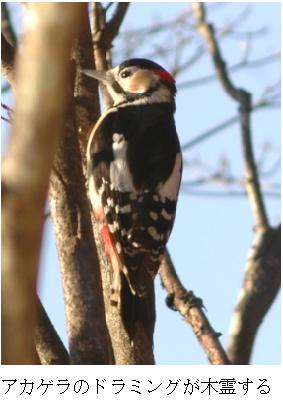
ソフィアート・ガーデンの小鳥たちは、都会のドバトやスズメのような、ちょっとずうずうしい感じの慣れ方ではなく、あくまで人間との距離を保ちつつ、信頼を築いた私どもとの間だけで、ほんのひとときの期間ではありますが、ささやかで確かな友情を結んでくれる、かけがえのない存在です。
こうした行為には、自然への介入だとか、人間と野生動物の接近は好ましくないなどの批判もあるかもしれませんが、実際には、野鳥はもっと利口でしたたかです。彼らは自然の中で、厳冬期から春先の期間を限定して私どもとコンタクトしているだけであり、決してそれ以上頼ろうとはしません。
春に混群からツガイ関係を結ぶ繁殖期に入ると、もう人間のことは見向きもしなくなります。基本的な信頼関係はあるものの、やがてたくさんの雛を育てるために休む間もなく働く彼らには、ヒトに構っている暇などありません。
外では、さかんに縄張り宣言の「さえずり」がこだまし、また小さな声で求愛給餌(プロポーズ)している声も聞こえてきます。野鳥たちが遊んでくれるのもあと残りわずか。遊んでもらえなくなる身としては寂しいですが、これからは自然の中でたくましく生きる野鳥の尊厳を、遠くから見守る季節の到来です。
『 ソフィアート・ガーデン物語 』 第5話 「小鳥の友情」
有限会社ソフィアート スタッフM( 竺原 みき )
関連する物語
>> 第21話「小鳥の性格」
>> 第22話「小鳥の友情 2」
>> 第27話「小鳥の感情」
>> 第40話「托卵」(ヤマガラのタク)
>> 第86話「小鳥の性格 2」
The Tale of Sophiart Garden
>>To the Previous Story | >>To the Next Story
Chapter 5
“A Friendship with Little Birds”
April 16, 2012
There’s a well-known tale about chasing after a bluebird in hopes of capturing happiness. But have you ever heard of a story where birds are the ones doing the chasing? While that might be a nightmare for an insect, for a human, it would surely be a delightful experience.
As I walk through Sophiart Garden, little birds suddenly appear out of nowhere, flitting about excitedly and calling out in tiny bell-like voices, “Tttt!” or “Sususu!”—a cheerful signal meant for me. Looking up to find the source of the sound, I see a small bird perched on a nearby branch, gazing at me expectantly. More often than not, it’s a Varied Tit or a Willow Tit, sometimes a Coal Tit, and occasionally even a Japanese Tit.
Whenever this happens, no matter how busy we are with gardening—whether holding a shovel, rake, or broom, or in the middle of an important task—we immediately drop everything, reach into our pockets, and offer them a small gift. The gifts vary: sunflower seeds, pieces of peanuts or walnuts, or sometimes the fruit of the Japanese Snowbell.
With unmistakable delight, the little birds flutter onto our outstretched hands, lock eyes with us for a brief moment, then gracefully return to their perches with their chosen treat firmly grasped in both feet. They nibble away, emitting those soft “sususu” sounds of happiness. Occasionally, one will cleverly stash its treat away somewhere and return for more, as if hoping we won’t notice.
Throughout winter, we always carry these little gifts in our pockets when we go out to the garden. If we were to walk around empty-handed, we might disappoint the birds who have flown in from afar to visit us.
Of course, these birds are not pets but wild creatures living freely in nature. Japan’s Wildlife Protection Law safeguards them, and it’s important that we maintain a respectful distance while interacting with them.
That’s why, in Sophiart Garden, we only provide them with small offerings during the harsh winter months when the ground is frozen solid and food is scarce. For this, we hang a simple woven basket filled with sunflower seeds on a tree during the daytime.
In English-speaking countries, bird feeders are incredibly popular, available in a dazzling array of clever and stylish designs as garden accessories. Japan, too, has specialty stores that sell beautifully crafted birdhouses and feeders.
Our feeder is nothing more than a humble woven basket, yet it is beloved by our little visitors. As we carry the basket to hang it on a tree, we can feel the birds’ eager anticipation—some already perched nearby, watching our every move with excitement.
Some of the friendlier ones even land directly on the basket while it’s still in our hands or hover just a few inches away, peering at us curiously, sometimes even playfully trying to get our attention.
In moments like these, we calm our minds, becoming as still as trees. We move as slowly as possible, taking care not to startle them. We whisper softly, extending our hands like branches, keeping our thoughts as serene as a mirror-smooth pond. We clear our minds of all distractions and simply wait, imagining the light touch of a bird landing on our hand.
Then, in a fleeting moment, a feather-light bird alights on my palm. It peers into my eyes, then flits away without taking anything, as if testing my intent. But once it is reassured of my sincerity, it will eventually return, land on my hand with confidence, and accept my offering.
Before they take anything, they always make eye contact, reading our thoughts in an instant. If we avert our gaze or close our eyes, they sometimes hesitate, landing but not taking the treat before flying off again.
Over the course of two or three years, these encounters become routine. We grow familiar with each other, recognizing individual faces—yes, birds, like humans, have distinct faces. In return, the trust we build is passed down through generations as they raise their young.
The birds see everything we do—when we refill their water source with fresh water, when we plant trees they feel safe in, and when we carefully maintain their nesting boxes.
One particularly affectionate Varied Tit, overwhelmed with excitement, once swooped right between my hand and the nest box as I was installing it, as if celebrating its new home.
Through these simple daily interactions, a fundamental trust is established. Once that trust is there, the birds begin to express a wide range of emotions—far more complex than just joy. They show jealousy, hesitation, playfulness, mild frustration, and above all, a deep sense of friendship.
Some birds, despite having easy access to the food basket, will follow us around the garden instead, calling out in their tiny voices as if inviting us to play. Others, upon seeing us from a few meters away, will fly straight to our outstretched hands when we call them.
Each bird has its own distinct personality. Some are bold, while others are shy. But when a bird trusts you so much that it willingly perches on your hand, looking at you not as a source of food but as a friend, the feeling is indescribable—it sends literal goosebumps up your arms. In those moments, we are filled with an overwhelming sense of responsibility never to betray their trust.
Unlike the city pigeons or sparrows that grow bold around humans, the birds of Sophiart Garden maintain a respectful distance. And yet, within that space, they form a gentle and undeniable bond with us—a rare and precious friendship that lasts only for a short season each year.
Some may argue that humans should not interfere with nature, that wild animals and people should not grow too close. But in reality, wild birds are far more independent and resilient than we assume.
They seek out our company only during the harshest months, never relying on us beyond that. Once spring arrives and mating season begins, their focus shifts entirely to their partners and their nests. No matter how strong our bond, they suddenly have no time for us—they are too busy raising their chicks, tirelessly working to ensure their survival.
Now, the air is filled with territorial songs, and if we listen carefully, we can hear the gentle sounds of courtship feeding—tiny tokens of affection exchanged between mates.
Our time with them is drawing to a close for the year. It’s bittersweet, knowing they will soon leave us behind, but it’s also a reminder of their true nature. From now on, we will watch over them from afar, respecting their wild independence, until winter comes once more.
The Tale of Sophiart Garden
Chapter 5:“A Friendship with Little Birds”
Miki Jikuhara, Sophiart Karuizawa
>>To the Previous Story | >>To the Next Story
Related Stories:
>> Chapter 21: “The Personalities of Little Birds”
>> Chapter 22:“A Friendship with Little Birds – Part 2”
>> Chapter 27:“The Emotions of Little Birds”
>> Chapter 40“Brood Parasitism” (The Story of Taku, the Varied Tit)
>>“Chapter 86 "The Personalities of Little Birds – Part 2”






